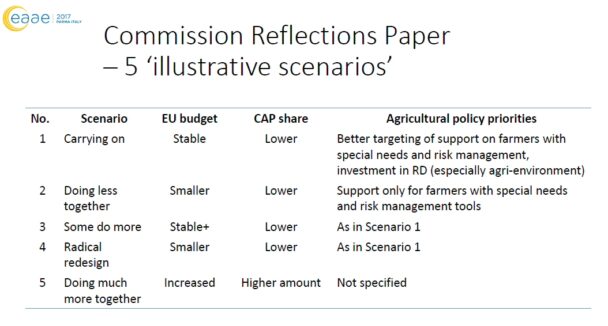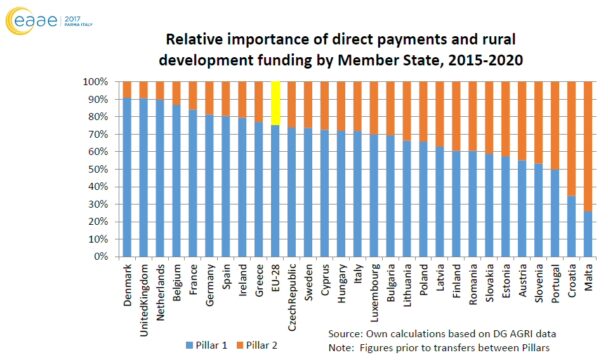Last week I attended the XVth Congress of the European Association of Agricultural Economists which was held in Parma, Italy. With almost 600 contributed papers, poster papers, organised sessions and panels, it was a feast both of stimulating ideas and great food. Over the next few weeks, I hope to highlight a few of the papers which were of interest to me. In this post, I take the opportunity to refer to my own contribution to an organised session on the economics and politics of the CAP after 2020.
This panel discussion also included contributions from Tassos Haniotis (DG AGRI), Jean-Christophe Bureau (AgriParisTech) and Johan Swinnen (University of Leuven). My contribution dealt with the state of play and the process of shaping the CAP post 2020, Haniotis and Bureau discussed some of the substantive issues under discussion, while Swinnen discussed the political economy of a reform agenda, drawing on analytical insights from previous CAP reforms.
My contribution highlighted the legislative and scheduling problems in preparing new legislation for the CAP after 2020. Decision-making in the European Union is slow! While for some people this is a criticism of EU processes, it also ensures that there is the opportunity for everyone around Europe to be able to evaluate the impact of a Commission proposal and to make their views known.
We can take the example of the so-called Omnibus Regulation which is designed to simplify financial procedures for different EU spending areas, including the CAP. The legislation was proposed by the Commission in September 2016 in the hope that it would be agreed within a twelve-month period, allowing any changes to be introduced for the 2018 financial year. Both the Council and Parliament have agreed their positions on this legislation, and the trilogues take place this month with the last one scheduled for October 2nd. Even assuming agreement is reached, both Council and Parliament would still have to follow their formal procedures to adopt the legislation on first reading. So, at best, this supposedly uncontroversial legislation will have taken at least 13 months to approve.
The Omnibus Regulation is intended to address the rules around the disbursement of EU funds, but not to change the substance of policy (although COMAGRI has used the opportunity to propose some policy changes to the CAP, see my post here and that of Paolo de Castro here on these amendments). Nonetheless, even this relatively innocuous legislation takes at least 13 months for agreement to be reached (assuming the trilogues do reach agreement in early October). Recall that the last CAP reform took two years from the very initial publication of the Commission proposals (in June 2011 as part of the Multiannual Financial Framework (MFF) proposal for the 2014-2020 period) to political agreement in June 2013, and the final legislative approval did not come until December 2013.
Timeline for revision of the CAP regulations
What do these timelines mean for the CAP after 2020? Following the Commission’s initiative on modernising and simplifying the CAP, Commissioner Hogan has indicated that he intends to publish a Commission Communication towards the end of this year. This will be in the nature of a Green Paper, setting out options and inviting reactions from stakeholders. In the light of the responses, the Commission may or may not make legislative proposals, but the earliest point these could be made would be Spring 2018. At that point, there would be just 12 months until March 2019 when the Parliament will rise and move to elections to be held in June 2019.
It seems rather clear that any legislative proposal to revise the CAP basic acts put forward (at the earliest) in March 2018 would stand no chance of passing both Council and Parliament before the end of this Parliament’s term. At first sight, this might not be an insurmountable obstacle. The Parliament’s rules of procedure on unfinished business state that all votes taken by Parliament in plenary before the elections, whether at first reading, or second reading, or under the consultation procedure, remain legally valid for the next Parliament. This means that after the elections the new Parliament would pick up the files where the previous Parliament left them and would continue with the next stage of the decision-making procedure.
However, for legislative business that does not reach the plenary before the elections, there is no legally valid Parliament position and Parliament’s rules stipulate that in these cases the work done on them (in committee) during the previous parliamentary term lapses. Nonetheless, at the beginning of the new parliamentary term, the new Parliament’s Conference of Presidents – formed of the EP President and the political group leaders – may decide, on the basis of a request from the relevant parliamentary committees, to continue the work already done on those files (rules 63 and 229 of the EP’s rules of procedure). However, it seems very unlikely that COMAGRI would have advanced very far in its deliberations by the end of this Parliamentary term.
Any consideration of Commission proposals on CAP legislation post 2020 would be intimately intertwined with the parallel debate on the next MFF. The Commission proposal on the next MFF is due by the end of this year, but the Budget Commissioner has indicated that, due to the uncertainties around Brexit as well as the ongoing debate around the White Paper on the Future of Europe, this proposal may well be delayed until, perhaps, the middle of next year. Based on previous experience of MFF negotiations in the European Council, and given the many new factors which have entered the mix in deciding the EU budget (see below), it is likely to take the European Council at least 18 months after the Commission makes its proposal before a new MFF could be agreed.
In the debate on the 2013 CAP reform, the Parliament (in the form of COMAGRI) refused to even begin discussing the Commission proposal until the size of the CAP budget for the 2014-2020 period was known (for a detailed review of the links between the MFF and CAP negotiations in the 2013 reform, see my working paper The impact of the simultaneous MFF negotiations on the European Parliament’s influence on the 2013 CAP reform). There are good strategic reasons for this, and it is highly likely that the Parliament would adopt the same position on the next occasion. Thus, if the CAP figures in the new MFF are not known in the term of the current Parliament, we cannot expect any serious consideration by COMAGRI of any Commission proposal made in the first half of next year.
The bottom line – getting substantial CAP2020 legislation through in this Parliamentary term is a non-starter. The very best that the Commission might hope for is to get a CAP-lite revision through in 12 months provided it was focused on just a very small number – one or two – of key issues. But under co-decision the Commission can no longer control the process once its proposal is made. As we saw with the Omnibus Regulation, both COMAGRI and the Council will want to adorn the Commission proposal with their own amendments. This might diminish the chances of success of even a CAP-lite package passing in the current Parliamentary period.
After October 2019, there will be a new Parliament and a new Commission and, who knows, potentially a new Commissioner. Elections around the EU may also change the make-up of the Council, and on current plans the UK will no longer be around. It is surely possible that the new teams in place will want to put their own stamp on the shape of the future CAP. A reasonable expectation is that we might see a revised Commission proposal (if one is made in early 2018) or a new one in early 2020 when the new Commission has settled in. In this scenario, any expectation of revisions in the CAP basic regulations will be postponed until 2022 or 2023 with implementation starting in 2024 or 2025. The CAP we have today will be around for the best part of a decade.
The MFF budgetary context
The paradoxical conclusion, however, is that this does not mean an unchanged CAP after 2020. This is because the next MFF (assuming agreement is reached in the European Council) will take effect from 1 January 2021. All the signals are that the CAP budget will be reduced in relative terms and also in absolute terms in the next MFF. A reduction in CAP funding is bound to have knock-on effects on the shape of the CAP.
The pressures on the CAP budget are well known. The CAP continues to be the largest single spending item in the EU budget, accounting for around 40% of the total. There is great reluctance among Member States to increase the overall size of the budget, yet the EU needs to address significant new challenges, especially with respect to migration, security and growth. The departure of the United Kingdom will add to these pressures if it leaves a hole in the EU budget (the UK is the second largest net contributor to the budget after Germany), although this will depend, in part, on the terms of the ‘divorce settlement’ agreed as part of the Brexit negotiations.
Last June, the Commission published a Reflections Paper on the Future of EU Finances: Five Scenarios – Implications. This followed the publication of the White Paper on the Future of Europe in March in which five scenarios for the future development of the European Union were set out. President Juncker will use the opportunity of his State of the Union Address to the European Parliament in ten days time (September 13) to set out his personal views on the future of Europe. The intention is that the European Council will draw first conclusions at its meeting in December 2017. This in turn will help to decide on a course of action to be rolled out in time for the European Parliament elections in June 2019.
Based on these five scenarios, the Reflections Paper on the future of the EU finances examined the implications of these scenarios for the size and composition of the EU budget. Its conclusions are summarised in the following slide from my EAAE presentation. The take-home message is that in all scenarios except the fifth (which assumes a commitment to a significant step up in the degree of European integration), the CAP budget will be lower. The CAP will take a smaller share of the EU budget, and in some scenarios this overall budget will also be reduced. While no specific figures are mentioned in the paper, it might not be unreasonable to assume a 30% reduction in the CAP budget in the next MFF period.

Another wrinkle is whether the Commission will propose, and whether the European Council would determine, that there should be a further move towards external convergence, i.e. the levelling of direct payments per hectare of eligible area between Member States. Even without any cut in overall CAP funding, this would further reduce Pillar 1 payments in some older Member States but would increase them in some of the newer Member States.
For the purposes of this discussion, let us assume that a reduction in the CAP budget occurs. The European Council must then decide how to distribute this reduction across Pillars 1 and 2 of the CAP (note that this decision is for the European Council and does not depend on the progress of CAP legislation). Would it decide to make the cuts disproportionately in Pillar 1 payments, or conversely (as happened in 2013), would it decide to disproportionately cut Pillar 2 payments?
Member States are likely to hold different views on this issue. One reason is that one way to offset cuts in the Pillar 1 budget on transfers to farmers would be to introduce co-responsibility and national financing for these payments. This option is one mentioned specifically in the Commission’s Reflections Paper. Some governments (e.g. Germany?) might well be attracted to the idea of a lower CAP Pillar 1 budget if they were given permission to make national payments to their farmers to make up the difference. Other countries, conscious of the additional strain this would put on their national finances, would be likely to reject the introduction of national co-financing for Pillar 1 payments and seek to maintain the level of Pillar 1 spending in the CAP and to make the reductions disproportionately in Pillar 2 payments.
Another factor likely to influence Member State positions is that the relative importance of Pillar 1 direct payments and Pillar 2 rural development payments differs across Member States (see diagram below). For France and Belgium, Pillar 1 payments are well over 80% of their pre-allocated funding under the CAP, while for countries such as Romania, Austria and Slovenia they account for less than 60% of their total CAP payments. Other things equal, the latter countries might be happier to make cuts in Pillar 1 payments (which would have less effect on them) and conversely, countries to the left of the diagram would be happier to see cuts fall predominantly on the Pillar 2 budget.

One way to resolve this dilemma would be to merge Pillar 1 and Pillar 2 payments into a single pot for budget allocations (this would not prejudge whether we retain the two-pillar structure in operational terms). The European Council moved towards this solution when agreeing the 2014-2020 MFF in that, while pre-allocating specific amounts to each Member State for Pillar 1 and Pillar 2 spending, it introduced the possibility, within limits, for Member States to move funds from one Pillar to the other. One prediction might be that this flexibility will be further enhanced in the next MFF, simply in order to facilitate an agreement on the CAP budget in the MFF.
Conclusions
In this post, I have argued that we are unlikely to see substantial revisions to the CAP basic legislation until well into the next decade. The Ciolos reform is likely to last for a decade, despite the dissatisfaction with the outcomes of this reform among stakeholders from all sides. On the other hand, farmers and paying agencies may be relieved that further fundamental revisions to the structure of the CAP are postponed for a further six or seven years, given that there is a value in itself to policy stability.
This does not preclude the possibility that the Commissioner might be able to push through a CAP-lite revision if it focused on just one or maybe two issues. Currently, a public consultation is underway on improvements to the food supply chain, in the wake of the Agricultural Markets Task Force report, with a view to deciding if a legislative initiative is needed. Such an initiative early next year, if introduced, might well be successful in passing even in the limited time available, given the high degree of convergence of views between the Parliament and the Council on this issue. One could imagine other single-issue initiatives, such as on generational renewal, or focusing specifically on changes to the Rural Development regulation to give greater emphasis and priority to climate action, also succeeding in the limited time to March 2019.
However, I have also argued that farmers will face a very different world from 2021 on because of the budgetary context even in the absence of any comprehensive revision of the basic CAP legislation. There is mounting evidence, including most recently the scenarios set out in the Commission’s Reflections Paper on the future of EU finances, that there will be a significant reduction in the CAP budget in the next MFF. If this occurs, it would be accompanied by a major debate within the European Council on how to allocate this reduction between the two Pillars.
Member States are likely to hold very different views on this question. The simplest way to resolve these differences might be to further enlarge the flexibility of Member States to transfer EU resources between Pillars. On the last occasion, this led to a net increase in the resources available to Pillar 2 (relative to the European Council’s initial proposal which cut Pillar 2 resources disproportionately more than Pillar 1). The outcome the next time round, it seems to me, remains wide open at this stage.
Paradoxically, farmers might well hope that the European Council fails to reach agreement on the next MFF in time for it to enter into force at the beginning of 2021. Under the Treaty rules, in the case of no agreement on a new MFF before the end of the previous MFF, ceilings and other provisions corresponding to the last year of that MFF are extended until agreement is reached. This would mean that the ceilings on CAP expenditure would remain as under the current MFF rather than be reduced as is likely under the next MFF. Resources under these ceilings would have to be activated under the annual budget procedure but, in principle, a delay in agreeing the next MFF would allow CAP spending to continue at current levels for a little longer.
My full presentation to the EAAE organised session on the economics and politics of the CAP after 2020 is available below.
This post was written by Alan Matthews



Small correction Alan, see line “until 2022 or 2023 with implementation starting in 2004 or 2005” in above piece.
Thanks for a very informative read (yet again!)
Many thanks, Tony, I have now corrected that. Appreciate the eagle eye….